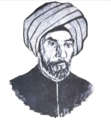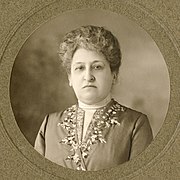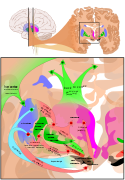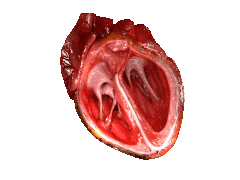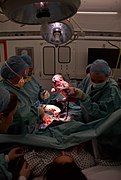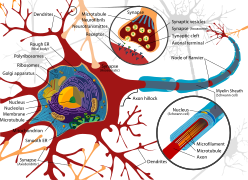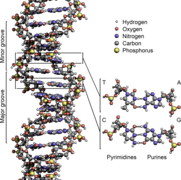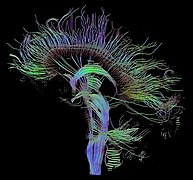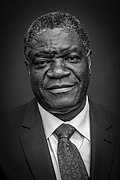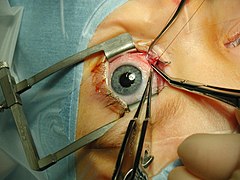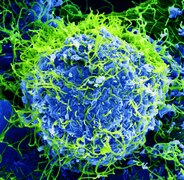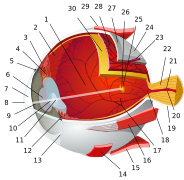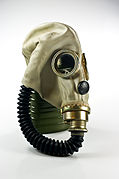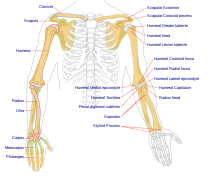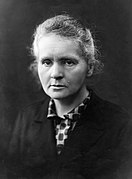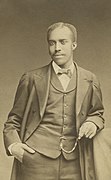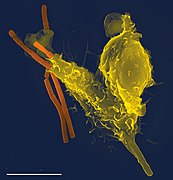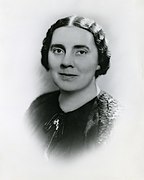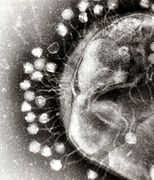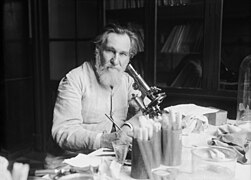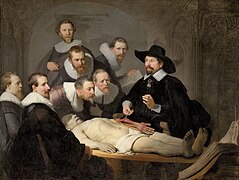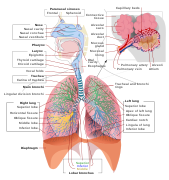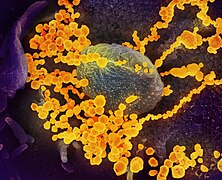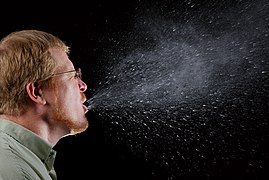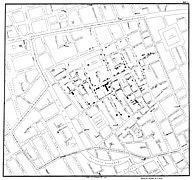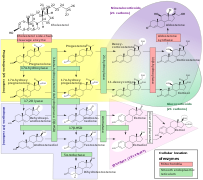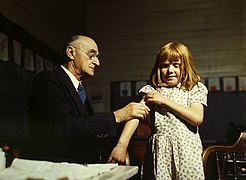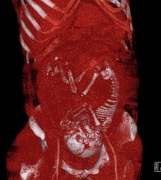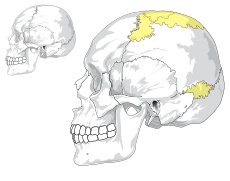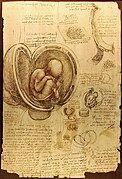Portal:Medicine
The Medicine Portal

Medicine is the science and practice of caring for a patient, managing the diagnosis, prognosis, prevention, treatment, palliation of their injury or disease, and promoting their health. Medicine encompasses a variety of health care practices evolved to maintain and restore health by the prevention and treatment of illness. Contemporary medicine applies biomedical sciences, biomedical research, genetics, and medical technology to diagnose, treat, and prevent injury and disease, typically through pharmaceuticals or surgery, but also through therapies as diverse as psychotherapy, external splints and traction, medical devices, biologics, and ionizing radiation, amongst others.
Medicine has been practiced since prehistoric times, and for most of this time it was an art (an area of creativity and skill), frequently having connections to the religious and philosophical beliefs of local culture. For example, a medicine man would apply herbs and say prayers for healing, or an ancient philosopher and physician would apply bloodletting according to the theories of humorism. In recent centuries, since the advent of modern science, most medicine has become a combination of art and science (both basic and applied, under the umbrella of medical science). For example, while stitching technique for sutures is an art learned through practice, knowledge of what happens at the cellular and molecular level in the tissues being stitched arises through science.
Prescientific forms of medicine, now known as traditional medicine or folk medicine, remain commonly used in the absence of scientific medicine and are thus called alternative medicine. Alternative treatments outside of scientific medicine with ethical, safety and efficacy concerns are termed quackery. (Full article...)
-
Oliver Wendell Holmes Sr. (/hoʊmz/; August 29, 1809 – October 7, 1894) was an American physician, poet, and polymath based in Boston. Grouped among the fireside poets, he was acclaimed by his peers as one of the best writers of the day. His most famous prose works are the "Breakfast-Table" series, which began with The Autocrat of the Breakfast-Table (1858). He was also an important medical reformer. In addition to his work as an author and poet, Holmes also served as a physician, professor, lecturer, inventor, and, although he never practiced it, he received formal training in law.
Born in Cambridge, Massachusetts, Holmes was educated at Phillips Academy and Harvard College. After graduating from Harvard in 1829, he briefly studied law before turning to the medical profession. He began writing poetry at an early age; one of his most famous works, "Old Ironsides", was published in 1830 and was influential in the eventual preservation of the USS Constitution. Following training at the prestigious medical schools of Paris, Holmes was granted his Doctor of Medicine degree from Harvard Medical School in 1836. He taught at Dartmouth Medical School before returning to teach at Harvard and, for a time, served as dean there. During his long professorship, he became an advocate for various medical reforms and notably posited the controversial idea that doctors were capable of carrying puerperal fever from patient to patient. Holmes retired from Harvard in 1882 and continued writing poetry, novels and essays until his death in 1894. (Full article...) -
Helium (from Greek: ἥλιος, romanized: helios, lit. 'sun') is a chemical element; it has symbol He and atomic number 2. It is a colorless, odorless, tasteless, non-toxic, inert, monatomic gas and the first in the noble gas group in the periodic table. Its boiling point is the lowest among all the elements, and it does not have a melting point at standard pressures. It is the second-lightest and second most abundant element in the observable universe, after hydrogen. It is present at about 24% of the total elemental mass, which is more than 12 times the mass of all the heavier elements combined. Its abundance is similar to this in both the Sun and Jupiter, because of the very high nuclear binding energy (per nucleon) of helium-4, with respect to the next three elements after helium. This helium-4 binding energy also accounts for why it is a product of both nuclear fusion and radioactive decay. The most common isotope of helium in the universe is helium-4, the vast majority of which was formed during the Big Bang. Large amounts of new helium are created by nuclear fusion of hydrogen in stars.
Helium was first detected as an unknown, yellow spectral line signature in sunlight during a solar eclipse in 1868 by Georges Rayet, Captain C. T. Haig, Norman R. Pogson, and Lieutenant John Herschel, and was subsequently confirmed by French astronomer Jules Janssen. Janssen is often jointly credited with detecting the element, along with Norman Lockyer. Janssen recorded the helium spectral line during the solar eclipse of 1868, while Lockyer observed it from Britain. However, only Lockyer proposed that the line was due to a new element, which he named after the Sun. The formal discovery of the element was made in 1895 by chemists Sir William Ramsay, Per Teodor Cleve, and Nils Abraham Langlet, who found helium emanating from the uranium ore cleveite, which is now not regarded as a separate mineral species, but as a variety of uraninite. In 1903, large reserves of helium were found in natural gas fields in parts of the United States, by far the largest supplier of the gas today. (Full article...) -
In the early 20th century, German researchers found additional evidence linking smoking to health harms, which strengthened the anti-tobacco movement in the Weimar Republic and led to a state-supported anti-smoking campaign. Early anti-tobacco movements grew in many nations from the middle of the 20th century. The 1933–1945 anti-tobacco campaigns in Nazi Germany have been widely publicized, although stronger laws than those passed in Germany were passed in some American states, the UK, and elsewhere between 1890 and 1930. After 1941, anti-tobacco campaigns were restricted by the Nazi government.
The German movement was the most powerful anti-smoking movement in the world during the 1930s and early 1940s. Some Nazi leaders condemned smoking and several of them openly criticized tobacco consumption, but others publicly smoked and denied that it was harmful. (Full article...) -

Major General Rupert Major Downes, CMG, KStJ, VD, FRACS (10 February 1885 – 5 March 1945) was an Australian soldier, surgeon and historian.
The son of British Army officer Major Francis Downes, Downes joined the Army as a trumpeter while he was still at school. He attended the University of Melbourne, graduating with his medical degrees in 1907 and a Doctor of Medicine degree in 1911. He was commissioned as a captain in the Australian Army Medical Corps in 1908, and after the outbreak of the First World War he joined the First Australian Imperial Force (AIF) in 1914 as its youngest lieutenant colonel. He served in the Gallipoli campaign, and was appointed Assistant Director of Medical Services (ADMS) of the newly formed Anzac Mounted Division in 1916, which he combined with the post of ADMS AIF Egypt. In 1917, he became Deputy Director of Medical Services (DDMS) of the Desert Mounted Corps. After the war, he wrote articles on medical aspects of the Sinai and Palestine campaign, and the section on the campaign for the Official History of Australia in the War of 1914–1918. (Full article...) -
Oxygen toxicity is a condition resulting from the harmful effects of breathing molecular oxygen (O
2) at increased partial pressures. Severe cases can result in cell damage and death, with effects most often seen in the central nervous system, lungs, and eyes. Historically, the central nervous system condition was called the Paul Bert effect, and the pulmonary condition the Lorrain Smith effect, after the researchers who pioneered the discoveries and descriptions in the late 19th century. Oxygen toxicity is a concern for underwater divers, those on high concentrations of supplemental oxygen, and those undergoing hyperbaric oxygen therapy.
The result of breathing increased partial pressures of oxygen is hyperoxia, an excess of oxygen in body tissues. The body is affected in different ways depending on the type of exposure. Central nervous system toxicity is caused by short exposure to high partial pressures of oxygen at greater than atmospheric pressure. Pulmonary and ocular toxicity result from longer exposure to increased oxygen levels at normal pressure. Symptoms may include disorientation, breathing problems, and vision changes such as myopia. Prolonged exposure to above-normal oxygen partial pressures, or shorter exposures to very high partial pressures, can cause oxidative damage to cell membranes, collapse of the alveoli in the lungs, retinal detachment, and seizures. Oxygen toxicity is managed by reducing the exposure to increased oxygen levels. Studies show that, in the long term, a robust recovery from most types of oxygen toxicity is possible. (Full article...) -
Paul Nobuo Tatsuguchi (辰口 信夫, Tatsuguchi Nobuo), sometimes mistakenly referred to as Nebu Tatsuguchi (August 31, 1911 – May 30, 1943), was a Japanese soldier and surgeon who served in the Imperial Japanese Army (IJA) during World War II. He was killed during the Battle of Attu on Attu Island, Alaska, United States, on May 30, 1943.
A devout Seventh-day Adventist, Tatsuguchi studied medicine and was licensed as a physician in the United States (US). He returned to his native Japan to practice medicine at the Tokyo Adventist Sanitarium, where he received further medical training. In 1941, he was ordered to cease his medical practice and conscripted into the IJA as an acting medical officer, although he was given an enlisted rather than officer rank because of his American connections. In late 1942, Tatsuguchi was sent to Attu, which had been occupied by Japanese forces in June 1942. On May 11, 1943, The United States Army landed on the island, intending to retake American soil from the Japanese. (Full article...) -
Brigadier Sir Neil Hamilton Fairley, KBE, CStJ, FRACP, FRCP, FRCPE, FRS (15 July 1891 – 19 April 1966) was an Australian physician, medical scientist, and army officer who was instrumental in saving thousands of Allied lives from malaria and other diseases.
A graduate of the University of Melbourne, where he was resident of Ormond College, Fairley joined the Australian Army Medical Corps in 1915. He investigated an epidemic of meningitis that was occurring in Army camps in Australia. While with the 14th General Hospital in Cairo, he investigated schistosomiasis (then known as bilharzia) and developed tests and treatments for the disease. In the inter-war period he became renowned as an expert on tropical medicine. (Full article...) -
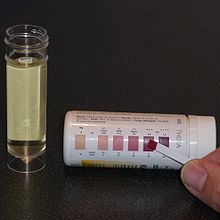
Testing for ketone bodies in urine
The ketogenic diet is a high-fat, adequate-protein, low-carbohydrate dietary therapy that in conventional medicine is used mainly to treat hard-to-control (refractory) epilepsy in children. The diet forces the body to burn fats rather than carbohydrates.
Normally, carbohydrates in food are converted into glucose, which is then transported around the body and is important in fueling brain function. However, if only a little carbohydrate remains in the diet, the liver converts fat into fatty acids and ketone bodies, the latter passing into the brain and replacing glucose as an energy source. An elevated level of ketone bodies in the blood (a state called ketosis) eventually lowers the frequency of epileptic seizures. Around half of children and young people with epilepsy who have tried some form of this diet saw the number of seizures drop by at least half, and the effect persists after discontinuing the diet. Some evidence shows that adults with epilepsy may benefit from the diet and that a less strict regimen, such as a modified Atkins diet, is similarly effective. Side effects may include constipation, high cholesterol, growth slowing, acidosis, and kidney stones. (Full article...) -
Thyrotoxic periodic paralysis (TPP) is a rare condition featuring attacks of muscle weakness in the presence of hyperthyroidism (overactivity of the thyroid gland). Hypokalemia (a decreased potassium level in the blood) is usually present during attacks. The condition may be life-threatening if weakness of the breathing muscles leads to respiratory failure, or if the low potassium levels lead to abnormal heart rhythms. If untreated, it is typically recurrent in nature.
The condition has been linked with genetic mutations in genes that code for certain ion channels that transport electrolytes (sodium and potassium) across cell membranes. The main ones are the L-type calcium channel α1-subunit and potassium inward rectifier 2.6; it is therefore classified as a channelopathy. The abnormality in the channel is thought to lead to shifts of potassium into cells, under conditions of high thyroxine (thyroid hormone) levels, usually with an additional precipitant. (Full article...) -
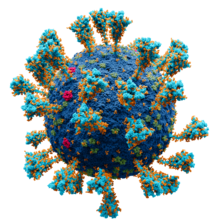
Illustration of a SARS-CoV-2 virion
A virus is a tiny infectious agent that reproduces inside the cells of living hosts. When infected, the host cell is forced to rapidly produce thousands of identical copies of the original virus. Unlike most living things, viruses do not have cells that divide; new viruses assemble in the infected host cell. But unlike simpler infectious agents like prions, they contain genes, which allow them to mutate and evolve. Over 4,800 species of viruses have been described in detail out of the millions in the environment. Their origin is unclear: some may have evolved from plasmids—pieces of DNA that can move between cells—while others may have evolved from bacteria.
Viruses are made of either two or three parts. All include genes. These genes contain the encoded biological information of the virus and are built from either DNA or RNA. All viruses are also covered with a protein coat to protect the genes. Some viruses may also have an envelope of fat-like substance that covers the protein coat, and makes them vulnerable to soap. A virus with this "viral envelope" uses it—along with specific receptors—to enter a new host cell. Viruses vary in shape from the simple helical and icosahedral to more complex structures. Viruses range in size from 20 to 300 nanometres; it would take 33,000 to 500,000 of them, side by side, to stretch to 1 centimetre (0.4 in). (Full article...) -
Rotaviruses are the most common cause of diarrhoeal disease among infants and young children. Nearly every child in the world is infected with a rotavirus at least once by the age of five. Immunity develops with each infection, so subsequent infections are less severe. Adults are rarely affected. Rotavirus is a genus of double-stranded RNA viruses in the family Reoviridae. There are nine species of the genus, referred to as A, B, C, D, F, G, H, I and J. Rotavirus A is the most common species, and these rotaviruses cause more than 90% of rotavirus infections in humans.
The virus is transmitted by the faecal–oral route. It infects and damages the cells that line the small intestine and causes gastroenteritis (which is often called "stomach flu" despite having no relation to influenza). Although rotavirus was discovered in 1973 by Ruth Bishop and her colleagues by electron micrograph images and accounts for approximately one third of hospitalisations for severe diarrhoea in infants and children, its importance has historically been underestimated within the public health community, particularly in developing countries. In addition to its impact on human health, rotavirus also infects other animals, and is a pathogen of livestock. (Full article...) -
Major depressive disorder (MDD), also known as clinical depression, is a mental disorder characterized by at least two weeks of pervasive low mood, low self-esteem, and loss of interest or pleasure in normally enjoyable activities. Introduced by a group of US clinicians in the mid-1970s, the term was adopted by the American Psychiatric Association for this symptom cluster under mood disorders in the 1980 version of the Diagnostic and Statistical Manual of Mental Disorders (DSM-III), and has become widely used since.
The diagnosis of major depressive disorder is based on the person's reported experiences, behavior reported by relatives or friends, and a mental status examination. There is no laboratory test for the disorder, but testing may be done to rule out physical conditions that can cause similar symptoms. The most common time of onset is in a person's 20s, with females affected about twice as often as males. The course of the disorder varies widely, from one episode lasting months to a lifelong disorder with recurrent major depressive episodes. (Full article...) -
Dark Archives: A Librarian's Investigation into the Science and History of Books Bound in Human Skin is a 2020 non-fiction book by the medical librarian and death-positive advocate Megan Rosenbloom. Dealing with anthropodermic bibliopegy, the binding of books in human skin, it expounds upon Rosenbloom's research on such books and their historical, ethical, and cultural implications.
The book focuses on the relationship between anthropodermic bibliopegy and the history of medicine; most confirmed cases of such books were created or owned by medical professionals, in contrast to common stereotypes that they were associated with Nazi Germany, serial killers, or the French Revolution. Rosenbloom discusses how the practice reflects the changing attitudes towards consent, ownership, and disposal of human bodies, and how the history of anthropodermic books intertwines with the history of medical ethics as a field. She interviews librarians, archivists, collectors, and experts on the topic, and examines notable examples of such books and their origins. Though Rosenbloom supports the preservation and maintenance of anthropodermic books, Dark Archives also covers arguments to the contrary, such as those espoused by Princeton University Library senior librarian Paul Needham. (Full article...) -

β-Hydroxy β-methylbutyric acid (HMB), otherwise known as its conjugate base, β-hydroxy β-methylbutyrate, is a naturally produced substance in humans that is used as a dietary supplement and as an ingredient in certain medical foods that are intended to promote wound healing and provide nutritional support for people with muscle wasting due to cancer or HIV/AIDS. In healthy adults, supplementation with HMB has been shown to increase exercise-induced gains in muscle size, muscle strength, and lean body mass, reduce skeletal muscle damage from exercise, improve aerobic exercise performance, and expedite recovery from exercise. Medical reviews and meta-analyses indicate that HMB supplementation also helps to preserve or increase lean body mass and muscle strength in individuals experiencing age-related muscle loss. HMB produces these effects in part by stimulating the production of proteins and inhibiting the breakdown of proteins in muscle tissue. No adverse effects from long-term use as a dietary supplement in adults have been found.
HMB is sold as a dietary supplement at a cost of about US$30–50 per month when taking 3 grams per day. HMB is also contained in several nutritional products, including certain formulations of Ensure and Juven. HMB is also present in insignificant quantities in certain foods, such as alfalfa, asparagus, avocados, cauliflower, grapefruit, and catfish. (Full article...) -
Frances Gertrude McGill (November 18, 1882 – January 21, 1959) was a Canadian forensic pathologist, criminologist, bacteriologist, allergologist and allergist. Nicknamed "the Sherlock Holmes of Saskatchewan" for her deductive skills and public fame, McGill influenced the development of forensic pathology in Canadian police work and was internationally noted for her expertise in the subject.
After completing her medical degree at the University of Manitoba in 1915, McGill moved to Saskatchewan, where she was hired first as the provincial bacteriologist and then as the provincial pathologist. She worked extensively with the Royal Canadian Mounted Police (RCMP) and local police forces for more than thirty years, and was instrumental in establishing the first RCMP forensic laboratory. She directed the RCMP laboratory for three years, and trained new RCMP recruits in forensic detection methods. After retiring in 1946, McGill was appointed Honorary Surgeon for the RCMP by the Canadian Minister of Justice, becoming one of the first official female members of the force, and she continued to act as a consultant to the RCMP until her death in 1959. (Full article...)
Selected image –
WikiProject

Get involved by joining WikiProject Medicine. We discuss collaborations and all manner of issues on our talk page.
Related portals
-
Two disposable injector pens containing insulin.
An injector pen (also called a medication pen) is a device used for injecting medication under the skin. First introduced in the 1980s, injector pens are designed to make injectable medication easier and more convenient to use, thus increasing patient adherence. The primary difference between injector pens and traditional vial and syringe administration is the easier use of an injector pen by people with low dexterity, poor vision, or who need portability to administer medicine on time. Injector pens also decrease the fear or adversity towards self-injection of medications, which increases the likelihood that a person takes the medication.
Injector pens are commonly used for medications that are injected repeatedly by a person over a relatively short period of time, especially insulin and insulin analogs used in the treatment of diabetes (called insulin pens). Many other medications are also available as injector pens, including other injectable medicines for diabetes, high cholesterol, migraine prevention, and other monoclonal antibodies. Studies have shown injector pens to be at least as effective as vial and syringe administration, and surveys have shown that a vast majority of people would prefer an injector pen over vial and syringe administration if one was available. After a slow uptake in the United States, injector pens have surpassed vial and syringe administration of insulin in type 2 diabetes. (Full article...) -

Aniru Sahib Sahib Conteh (6 August 1942 – 4 April 2004) was a Sierra Leonean physician and expert on the clinical treatment of Lassa fever, a viral hemorrhagic fever endemic to West Africa caused by the Lassa virus. Conteh studied medicine at the University of Ibadan in Nigeria and taught at Ibadan Teaching Hospital. He later returned to Sierra Leone where he joined the Centers for Disease Control and Prevention (CDC) Lassa fever program at Nixon Methodist Hospital in Segbwema, first as superintendent and then as clinical director.
After the Sierra Leone Civil War began in 1991, the CDC closed their program in Segbwema. Conteh and his medical team moved from Segbwema to the Kenema Government Hospital (KGH), where he spent the next two decades running the only dedicated Lassa fever ward in the world. Conteh collaborated with the British charity Merlin to promote public health in Sierra Leone through education and awareness campaigns intended to prevent Lassa fever. With little funding and few supplies, Conteh successfully reduced mortality rates and saved many lives until an accidental needlestick injury led to his own death from the disease in 2004. (Full article...) -
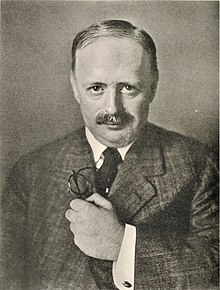
Elmer Ernest (E. E.) Southard (July 28, 1876 – February 8, 1920) was an American neuropsychiatrist, neuropathologist, professor and author. Born in Boston, Massachusetts, Southard lived in the city for nearly his entire life. He attended Boston Latin School and completed his education at Harvard University. At Harvard, Southard distinguished himself as a chess player. After briefly studying in Germany, he returned to the United States as a pathologist at Danvers State Hospital. Southard held academic appointments at Harvard University and its medical school.
He headed the Boston Psychopathic Hospital when it opened in 1912, pioneering the study of brain pathology with particular interests in shell shock and schizophrenia. Southard published several books, including Shell Shock and Other Neuropsychiatric Problems with nearly 1,000 case histories. He was president of the American Medico-Psychological Association and the Boston Society of Psychiatry and Neurology, and held advisory positions with the U.S. Chemical Warfare Service and the Eugenics Record Office. (Full article...) -
Ann Bishop (19 December 1899 – 7 May 1990) was a British biologist from Girton College at the University of Cambridge and a Fellow of the Royal Society, one of the few female Fellows of the Royal Society. She was born in Manchester but stayed at Cambridge for the vast majority of her professional life. Her specialties were protozoology and parasitology; early work with ciliate parasites, including the one responsible for blackhead disease in the domesticated turkey, lay the groundwork for her later research. While working towards her doctorate, Bishop studied parasitic amoebae and examined potential chemotherapies for the treatment of amoebic diseases including amoebic dysentery.
Her best known work was a comprehensive study of Plasmodium, the malaria parasite, and investigation of various chemotherapies for the disease. Later she studied drug resistance in this parasite, research that proved valuable to the British military in World War II. She discovered the potential for cross-resistance in these parasites during that same period. Bishop also discovered the protozoan Pseudotrichomonas keilini and worked with Aedes aegypti, a malaria vector, as part of her research on the disease. Elected to the Royal Society in 1959, Bishop was the founder of the British Society for Parasitology and served on the World Health Organization's Malaria Committee. (Full article...) -
Diabetic ketoacidosis (DKA) is a potentially life-threatening complication of diabetes mellitus. Signs and symptoms may include vomiting, abdominal pain, deep gasping breathing, increased urination, weakness, confusion and occasionally loss of consciousness. A person's breath may develop a specific "fruity" smell. The onset of symptoms is usually rapid. People without a previous diagnosis of diabetes may develop DKA as the first obvious symptom.
DKA happens most often in those with type 1 diabetes but can also occur in those with other types of diabetes under certain circumstances. Triggers may include infection, not taking insulin correctly, stroke and certain medications such as steroids. DKA results from a shortage of insulin; in response, the body switches to burning fatty acids, which produces acidic ketone bodies. DKA is typically diagnosed when testing finds high blood sugar, low blood pH and keto acids in either the blood or urine. (Full article...) -
Friedreich's ataxia (FRDA or FA) is an autosomal-recessive genetic disease that causes difficulty walking, a loss of coordination in the arms and legs, and impaired speech that worsens over time. Symptoms generally start between 5 and 20 years of age. Many develop hypertrophic cardiomyopathy and require a mobility aid such as a cane, walker, or wheelchair in their teens. As the disease progresses, some affected people lose their sight and hearing. Other complications may include scoliosis and diabetes mellitus.
The condition is caused by mutations in the FXN gene on chromosome 9, which makes a protein called frataxin. In FRDA, cells produce less frataxin. Degeneration of nerve tissue in the spinal cord causes the ataxia; particularly affected are the sensory neurons essential for directing muscle movement of the arms and legs through connections with the cerebellum. The spinal cord becomes thinner, and nerve cells lose some myelin sheath. (Full article...) -
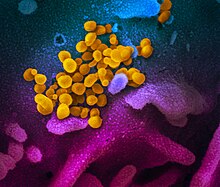
Colored Scanning electron microscope (SEM) image of SARS-CoV-2, speculated in 2020 as being the first virus to create Disease X
Disease X is a placeholder name that was adopted by the World Health Organization (WHO) in February 2018 on their shortlist of blueprint priority diseases to represent a hypothetical, unknown pathogen that could cause a future epidemic. The WHO adopted the placeholder name to ensure that their planning was sufficiently flexible to adapt to an unknown pathogen (e.g., broader vaccines and manufacturing facilities). Director of the US National Institute of Allergy and Infectious Diseases Anthony Fauci stated that the concept of Disease X would encourage WHO projects to focus their research efforts on entire classes of viruses (e.g., flaviviruses), instead of just individual strains (e.g., zika virus), thus improving WHO capability to respond to unforeseen strains. In 2020, experts, including some of the WHO's own expert advisors, speculated that COVID-19, caused by the SARS-CoV-2 virus strain, met the requirements to be the first Disease X. (Full article...) -
The Lafargue Mental Health Clinic, more commonly known as the Lafargue Clinic, was a mental health clinic that operated in Harlem, Manhattan, New York, from 1946 until 1958. The clinic was named for French Marxist physician Paul Lafargue and conceived by German-American psychiatrist Fredric Wertham, who recognized the dire state of mental health services for blacks in New York. With the backing of black intellectuals Richard Wright and Ralph Ellison, as well as members of the church and community, the clinic operated out of the parish house basement of St. Philip's Episcopal Church and was among the first to provide low-cost psychiatric health services to the poor, especially for poor blacks who either could not afford treatment at New York hospitals or faced racial discrimination from doctors and other hospital staff. The staff consisted entirely of volunteers, and Wertham and Hilde Mosse were the clinic's lead doctors.
Though the clinic only operated for 12 years, Wertham and Mosse's experiences from Lafargue were cited in a court decision to integrate schools in Wilmington, Delaware, and later in Brown v. Board of Education, which ruled that separate black and white schools were unconstitutional. Wertham would use case studies from his time at the clinic to support his later arguments that comic books caused juvenile delinquency, as evidenced in his 1954 work Seduction of the Innocent. (Full article...) -
Nessa Carey is a British biologist working in the field of molecular biology and biotechnology. She is International Director of the technology transfer organization PraxisUnico and a visiting professor at Imperial College London.
With expertise in the field of epigenetics and in technology transfer, she promotes the movement of scientists between academia and industry, lecturing often to school students and early career scientists. Carey writes books and articles for a scientifically interested general audience. She is the author of The Epigenetics Revolution and Junk DNA: A Journey Through the Dark Matter of the Genome which explore advances in the field of epigenetics and their implications for medicine. She edited Epigenetics for Drug Discovery for the Royal Society of Chemistry's Drug Discovery Series. (Full article...) -

One second sample of an EEG alpha oscillations . This rhythm occurs at frequencies similar to the mu rhythm, although alpha oscillations are detected over a different part of the brain.
The sensorimotor mu rhythm, also known as mu wave, comb or wicket rhythms or arciform rhythms, are synchronized patterns of electrical activity involving large numbers of neurons, probably of the pyramidal type, in the part of the brain that controls voluntary movement. These patterns as measured by electroencephalography (EEG), magnetoencephalography (MEG), or electrocorticography (ECoG), repeat at a frequency of 7.5–12.5 (and primarily 9–11) Hz, and are most prominent when the body is physically at rest. Unlike the alpha wave, which occurs at a similar frequency over the resting visual cortex at the back of the scalp, the mu rhythm is found over the motor cortex, in a band approximately from ear to ear. People suppress mu rhythms when they perform motor actions or, with practice, when they visualize performing motor actions. This suppression is called desynchronization of the wave because EEG wave forms are caused by large numbers of neurons firing in synchrony. The mu rhythm is even suppressed when one observes another person performing a motor action or an abstract motion with biological characteristics. Researchers such as V. S. Ramachandran and colleagues have suggested that this is a sign that the mirror neuron system is involved in mu rhythm suppression, although others disagree.
The mu rhythm is of interest to a variety of scholars. Scientists who study neural development are interested in the details of the development of the mu rhythm in infancy and childhood and its role in learning. Since a group of researchers believe that autism spectrum disorder (ASD) is strongly influenced by an altered mirror neuron system and that mu rhythm suppression is a downstream indication of mirror neuron activity, many of these scientists have kindled a more popular interest in investigating the mu wave in people with ASD. Assorted investigators are also in the process of using mu rhythms to develop a new technology: the brain–computer interface (BCI). With the emergence of BCI systems, clinicians hope to give the severely physically disabled population new methods of communication and a means to manipulate and navigate their environments. (Full article...) -
Attention deficit hyperactivity disorder (ADHD) is a neurodevelopmental disorder characterised by executive dysfunction occasioning symptoms of inattention, hyperactivity, impulsivity and emotional dysregulation that are excessive and pervasive, impairing in multiple contexts, and otherwise age-inappropriate.
ADHD symptoms arise from executive dysfunction, and emotional dysregulation is often considered a core symptom. Difficulties with self-regulation such as time management, inhibition and sustained attention may result in poor academic performance, unemployment and numerous health risks, collectively predisposing to a diminished quality of life and a direct average reduction in life expectancy of 13 years. ADHD is associated with other neurodevelopmental and mental disorders as well as some non-psychiatric disorders, which can cause additional impairment, especially in modern society. (Full article...) -

Amputation of the thigh by a railway surgery team c. 1898
Railway surgery was a branch of medical practice that flourished in the 19th and early 20th centuries. It concerned itself with the medical requirements of railway companies. Depending on country, it included some or all of: general practice for railway staff, trauma surgery as a result of accidents on the railways, occupational health and safety, medico-legal activities regarding compensation claims against the company, and occupational testing.
Railway surgery was especially well-developed in the US with formal professional organisations and scholarly journals. One of the reasons for this was that US railways were particularly dangerous with a high number of casualties from crashes and an even higher number of workers hurt in industrial accidents. Another reason was that many US routes passed through areas with little or no existing medical infrastructure. In Europe the railways were safer and infrastructure was generally already in place. The duties of railway surgeons in Europe mostly involved investigations into accidents and the resulting claims arising from passengers. In India the railways also faced a lack of existing medical infrastructure and, like the US, had to build it from scratch. Indian Railways still maintains a network of hospitals. (Full article...) -
Shellfish allergy is among the most common food allergies. "Shellfish" is a colloquial and fisheries term for aquatic invertebrates used as food, including various species of molluscs such as clams, mussels, oysters and scallops, crustaceans such as shrimp, lobsters and crabs, and cephalopods such as squid and octopus. Shellfish allergy is an immune hypersensitivity to proteins found in shellfish. Symptoms can be either rapid or gradual in onset. The latter can take hours to days to appear. The former may include anaphylaxis, a potentially life-threatening condition which requires treatment with epinephrine. Other presentations may include atopic dermatitis or inflammation of the esophagus. Shellfish is one of the eight common food allergens, responsible for 90% of allergic reactions to foods: cow's milk, eggs, wheat, shellfish, peanuts, tree nuts, fish, and soy beans.
Unlike early childhood allergic reactions to milk and eggs, which often lessen as the children age, shellfish allergy tends to first appear in school-age children and older, and persist in adulthood. Strong predictors for adult-persistence are anaphylaxis, high shellfish-specific serum immunoglobulin E (IgE) and robust response to the skin prick test. Adult onset of fish allergy is common in workers in the shellfish catching and processing industry. (Full article...) -

United States Army medic
The United States has compensated military veterans for service-related injuries since the Revolutionary War, with the current indemnity model established near the end of World War I. The Department of Veterans Affairs (VA) began to provide disability benefits for post-traumatic stress disorder (PTSD) in the 1980s after the diagnosis became part of official psychiatric nosology.
Post-traumatic stress disorder (PTSD) is a serious, potentially debilitating psychiatric disorder that can develop after experiencing one or more terrifying or horrific events. It is characterized by (1) re-experiencing the trauma(s) in the form of vivid intrusive memories, dissociative flashback episodes, or nightmares; (2) avoidance of trauma-related thoughts and memories; and (3) frequently feeling under threat manifested as, for example, hypervigilance and intense startle reactions. (Full article...) -
Brachytherapy is a form of radiation therapy where a sealed radiation source is placed inside or next to the area requiring treatment. Brachy is Greek for short. Brachytherapy is commonly used as an effective treatment for cervical, prostate, breast, esophageal and skin cancer and can also be used to treat tumours in many other body sites. Treatment results have demonstrated that the cancer-cure rates of brachytherapy are either comparable to surgery and external beam radiotherapy (EBRT) or are improved when used in combination with these techniques. Brachytherapy can be used alone or in combination with other therapies such as surgery, EBRT and chemotherapy.
Brachytherapy contrasts with unsealed source radiotherapy, in which a therapeutic radionuclide (radioisotope) is injected into the body to chemically localize to the tissue requiring destruction. It also contrasts to External Beam Radiation Therapy (EBRT), in which high-energy x-rays (or occasionally gamma-rays from a radioisotope like cobalt-60) are directed at the tumour from outside the body. Brachytherapy instead involves the precise placement of short-range radiation-sources (radioisotopes, iodine-125 or caesium-131 for instance) directly at the site of the cancerous tumour. These are enclosed in a protective capsule or wire, which allows the ionizing radiation to escape to treat and kill surrounding tissue but prevents the charge of radioisotope from moving or dissolving in body fluids. The capsule may be removed later, or (with some radioisotopes) it may be allowed to remain in place. (Full article...)
Did you know –
- ... that the most common cause of acute coronary syndrome is disruption of atherosclerotic plaque in a coronary artery?
- ... that the polymeal is a diet-based approach to combating heart disease, proposed in December 2004 by Oscar Franco?
- ... that a mammotome is a device that uses a computer-guided probe to perform breast biopsies, and that it can be conducted on an outpatient basis under local anaesthetic?
General images –
-
AMA Code of Medical Ethics (from Medical ethics)
-
Guy's Hospital in 1820 (from History of medicine)
-
The plinthios brochos as described by Greek physician Heraklas, a sling for binding a fractured jaw. These writings were preserved in one of Oribasius' collections. (from History of medicine)
-
Depiction of smallpox in Franciscan Bernardino de Sahagún's history of the conquest of Mexico, Book XII of the Florentine Codex, from the defeated Aztecs' point of view (from History of medicine)
-
Mandrake (written 'ΜΑΝΔΡΑΓΟΡΑ' in Greek capitals). Naples Dioscurides, 7th century (from History of medicine)
-
Most countries have seen a tremendous increase in life expectancy since 1945. However, in southern Africa, the HIV epidemic beginning around 1990 has eroded national health. (from History of medicine)
-
The emergency room is often a frontline venue for the delivery of primary medical care. (from Health care)
-
Magical stela or cippus of Horus inscribed with healing encantations (c. 332 to 280 BCE). (from History of medicine)
-
Statue of Robert Koch, father of medical bacteriology, at Robert-Koch-Platz (Robert Koch square) in Berlin (from History of medicine)
-
Infographic showing how healthcare data flows within the billing process (from Medical billing)
-
A doctor checks a patient's pulse in Meiji-era Japan. (from History of medicine)
-
healthcare expenditure in Japan by age group (from Health insurance)
-
Botánicas such as this one in Jamaica Plain, Boston, cater to the Latino community and sell folk medicine alongside statues of saints, candles decorated with prayers, lucky bamboo, and other items. (from Traditional medicine)
-
Global concentrations of health care resources, as depicted by the number of physicians per 10,000 individuals, by country. Data is sourced from a World Health Statistics 2010, a WHO report.[needs update] (from Health care)
-
Life Expectancy of the total population at birth among several OECD member nations. Data source: OECD's iLibrary (from Health insurance)
-
Life expectancy vs healthcare spending of rich OECD countries. US average of $10,447 in 2018. (from Health care)
-
The Edwin Smith Surgical Papyrus, written in the 17th century BCE, contains the earliest recorded reference to the brain. New York Academy of Medicine. (from History of medicine)
-
Sketch of Muslim physician Muhammad ibn Zakariya al-Razi (from History of medicine)
-
The Quaker-run York Retreat, founded in 1796, gained international prominence as a centre for moral treatment and a model of asylum reform following the publication of Samuel Tuke's Description of the Retreat (1813). (from History of medicine)
-
The numbers of Americans lacking health insurance and the uninsured rate from 1987 to 2008 (from Health insurance)
-
Zhang Zhongjing - a Chinese pharmacologist, physician, inventor, and writer of the Eastern Han dynasty. (from History of medicine)
-
Mexico City epidemic of 1737, with elites calling on the Virgin of Guadalupe (from History of medicine)
-
Yarrow, a medicinal plant found in human-occupied caves in the Upper Palaeolithic period. (from History of medicine)
-
Ethical prayer for medical wisdom by Dr Edmond Fernandes (from Medical ethics)
-
Portrait of Susruta, the author of the he Suśrutasamhitā which describes procedures on various forms of surgery, including rhinoplasty, (from History of medicine)
-
Hippocrates (c. 460–370 BCE). Known as the "father of medicine". (from History of medicine)
-
18th-century medical remedies collected by a British Gentry family (from History of medicine)
-
Total healthcare cost per person. Public and private spending. US dollars PPP. For example: $6,319 for Canada in 2022. $12,555 for the US in 2022. (from Health care)
-
Smallpox vaccination in Niger, 1969. A decade later, this was the first infectious disease to be eradicated. (from History of medicine)
-
Medicine during the First World War - Medical Transport. (from History of medicine)
-
Health spending by country. Percent of GDP (Gross domestic product). For example: 11.2% for Canada in 2022. 16.6% for the United States in 2022. (from Health care)
-
Galen (129–216 CE), Known for their wide insights into anatomy. (from History of medicine)
-
Primary care may be provided in community health centers. (from Health care)
-
Jackson Memorial Hospital in Miami, the primary teaching hospital of the University of Miami's Leonard M. Miller School of Medicine and the largest hospital in the United States with 1,547 beds (from Health care)
-
Taoist symbol of Yin and Yang (from Medical ethics)
-
Curandera performing a limpieza in Cuenca, Ecuador (from Traditional medicine)
-
Emil Kraepelin (1856–1926), the founder of modern scientific psychiatry, psychopharmacology and psychiatric genetics. (from History of medicine)
-
Patient, Surrey County Lunatic Asylum, c. 1850–58. The asylum population in England and Wales rose from 1,027 in 1827 to 74,004 in 1900. (from History of medicine)
-
A cochlear implant is a common kind of neural prosthesis, a device replacing part of the human nervous system. (from History of medicine)
-
Sometimes traditional medicines include parts of endangered species, such as the slow loris in Southeast Asia. (from Traditional medicine)
-
A Neo-Assyrian cuneiform tablet fragment describing medical text (c. 9th to 7th century BCE). (from History of medicine)
-
National Hospital for Neurology and Neurosurgery in London, United Kingdom is a specialist neurological hospital. (from Health care)
-
"More Doctors Smoke Camels than Any Other Cigarette" advertisement for Camel cigarettes in the 1940s (from Medical ethics)
-
American combat surgery during the Pacific War, 1943. Major wars showed the need for effective hygiene and medical treatment. (from History of medicine)
-
A cuneiform terracotta tablet describing a medicinal recipe for poisoning (c. 18th century BCE). Discovered in Nippur, Iraq.
-
COVID-19 swab testing in Rwanda (2021). (from History of medicine)
-
Medical personnel place sterilized covers on the arms of the daVinci Xi surgical system, a minimally-invasive robotic surgery system, at the William Beaumont Army Medical Center. (from History of medicine)
-
Health Expenditure per capita (in PPP-adjusted US$) among several OECD member nations. Data source: OECD's iLibrary (from Health insurance)
-
"Diagram of the causes of mortality in the army in the East" by Florence Nightingale. (from History of medicine)
-
A Ukrainian monument to the HIV pandemic. (from History of medicine)
More Did you know (auto generated)

- ... that Indian gynaecologist and reproductive medicine pioneer Baidyanath Chakrabarty, who performed over 4,000 IVF procedures, was a cricket fan who thought Virat Kohli and Ashwin were "such good boys"?
- ... that the spotted lanternfly has been used in traditional Chinese medicine to treat swelling since the 1100s?
- ... that Margaret C. Roberts was encouraged to study medicine by LDS Church leader Brigham Young to reduce mortality rates during childbirth?
- ... that Tang Zonghai was one of the first advocates for the integration of Chinese and Western medicine?
- ... that Constance Fozzard was told during her surgical training that women with children could not become consultants?
- ... that James A. Merriman was the only Black graduate from Rush Medical College in 1902 and the first African-American physician to practice medicine in Portland?
Topics
Categories
Recognized content
Associated Wikimedia
The following Wikimedia Foundation sister projects provide more on this subject:
-
Commons
Free media repository -
Wikibooks
Free textbooks and manuals -
Wikidata
Free knowledge base -
Wikinews
Free-content news -
Wikiquote
Collection of quotations -
Wikisource
Free-content library -
Wikiversity
Free learning tools -
Wiktionary
Dictionary and thesaurus




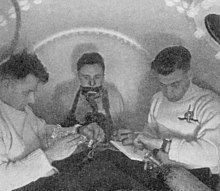



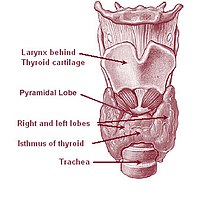

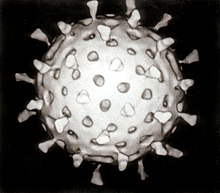
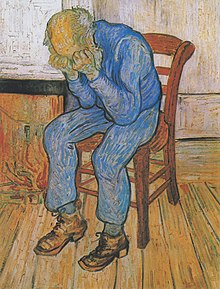



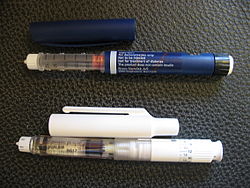



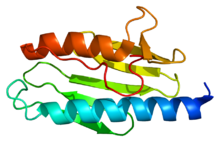
























![Image 16Global concentrations of health care resources, as depicted by the number of physicians per 10,000 individuals, by country. Data is sourced from a World Health Statistics 2010, a WHO report.[needs update] (from Health care)](http://upload.wikimedia.org/wikipedia/commons/thumb/1/1f/Global_physician_density_map_-_WHO_2010.png/120px-Global_physician_density_map_-_WHO_2010.png)



